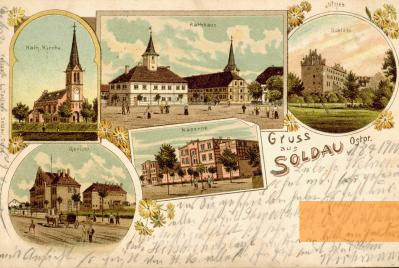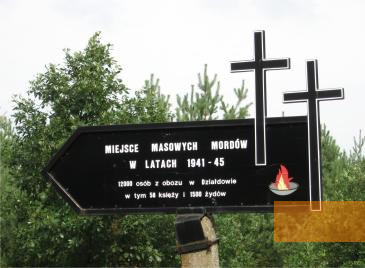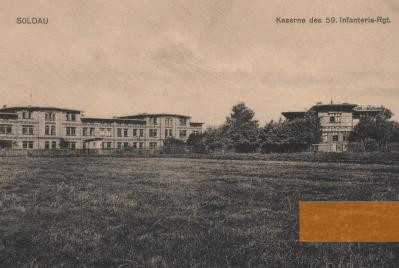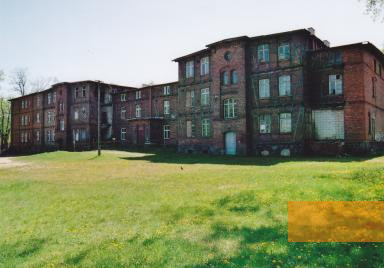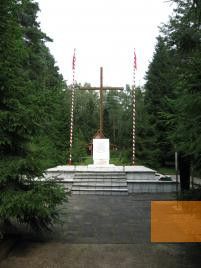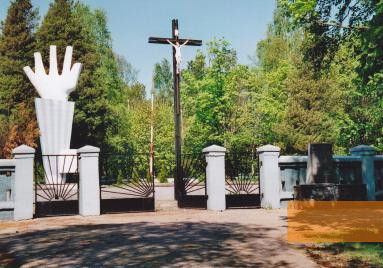In 1939/40, the SS camp in the small East Prussian town of Soldau (Polish: Działdowo) served as a prison in the course of the National Socialist persecution of the Polish elites; in 1940, it served as a killing centre as part of the »Euthanasia« programme, which entailed the murder of patients. Several monuments on the site and in nearby woods commemorate the camp's 13,000 to 20,000 victims.
At the beginning of the Second World War, in autumn 1939, the SS set up a transit camp for arrested Poles and Jews in the former army barracks of Soldau. In November 1939, Dr. Dr. Emil Otto Rasch arrived in Königsberg as inspector of the Security Police (SiPo) and the Security Service (SD). From January 1940 on, he was responsible for transferring prisoners – as part of the »Intelligenzaktion« against Polish elites – to Soldau. Between January and April, Rasch had at least 1,500 Poles and Jews, mostly academics, officers and priests, sentenced to death before a court-martial and executed. Single shootings took place on the premises of the camp, while mass executions were carried out in nearby forests, close to the villages of Bialutten (Białuty) and Kämmersdorf (Komorniki). In March 1940, hundreds were arrested in Płock and transferred to Soldau – among them were the 82-year old archbishop Antoni Julian Nowowiejski and suffragan bishop Leon Wetmański. Both perished at the beginning of 1941.
Already at the beginning of 1940, a special unit led by SS-Hauptsturmführer Herbert Lange murdered patients of hospitals in occupied Poland. At the end of May, the SS cleared the provincial hospitals in many East Prussian townships: the patients of the hospitals in Allenberg near Wehlau, Tapiau, Kortau and Carlshof near Rastenburg were all deported to Soldau and other facilities. Until June 8, 1940, »Sonderkommando Lange« murdered 1,558 German and up to 300 Polish disabled people in gas vans. In May 1940, the SS camp was transformed into a labour education camp which was used by all state police posts in East Prussia up until January 1945. In the spring of 1944, SS-Sonderkommando 1005 was ordered to carry out a »disinterment operation« near Soldau in order to erase the traces of the 1940/41 mass murders. On January 17, 1945, just before the Red Army reached Soldau, the SS sent the last remaining prisoners on a death march. Soon afterwards the camp was taken over by the Soviet secret service NKVD and used as a camp for Polish prisoners of war and »Volksdeutsche«, German nationals.
Already at the beginning of 1940, a special unit led by SS-Hauptsturmführer Herbert Lange murdered patients of hospitals in occupied Poland. At the end of May, the SS cleared the provincial hospitals in many East Prussian townships: the patients of the hospitals in Allenberg near Wehlau, Tapiau, Kortau and Carlshof near Rastenburg were all deported to Soldau and other facilities. Until June 8, 1940, »Sonderkommando Lange« murdered 1,558 German and up to 300 Polish disabled people in gas vans. In May 1940, the SS camp was transformed into a labour education camp which was used by all state police posts in East Prussia up until January 1945. In the spring of 1944, SS-Sonderkommando 1005 was ordered to carry out a »disinterment operation« near Soldau in order to erase the traces of the 1940/41 mass murders. On January 17, 1945, just before the Red Army reached Soldau, the SS sent the last remaining prisoners on a death march. Soon afterwards the camp was taken over by the Soviet secret service NKVD and used as a camp for Polish prisoners of war and »Volksdeutsche«, German nationals.
In total, between 20,000 and 50,000 people – possibly as many as 200,000 – passed through the Soldau camp from autumn 1939 until January 1945. The number of victims – representatives of the Polish elites, Jews as well as patients from psychiatric hospitals – is estimated to amount to 13,000 to 20,000 people.
After 1945, Soldau and all of southern East Prussia became part of Poland – the German residents were persecuted and driven away, while Polish expellees from the eastern part of Poland, now annexed by the Soviet Union, were resettled to this area. The newcomers discovered the mass graves of prisoners from the period between 1939 and 1944/45 in the woods near Białuty, south-east of Soldau (now called Działdowo), and in Komorniki to the north-east. Memorial sites now honour the thousands of victims. There is a further monument on the cemetery in Działdowo, where exhumed corpses were buried in eleven mass graves.
- Name
- Były obóz koncentracyjny w Działdowie


